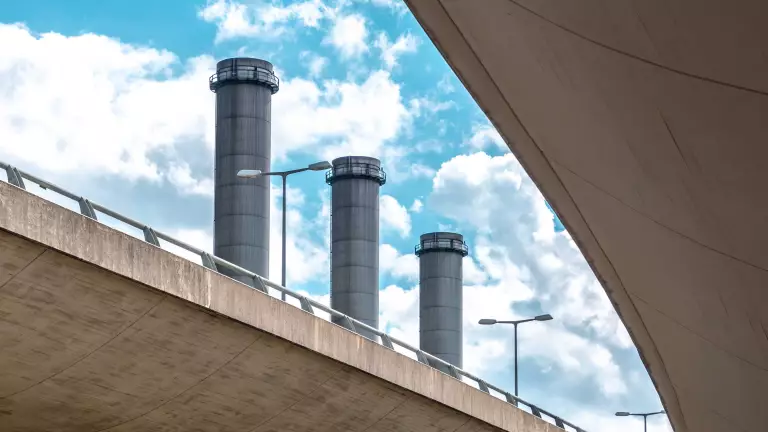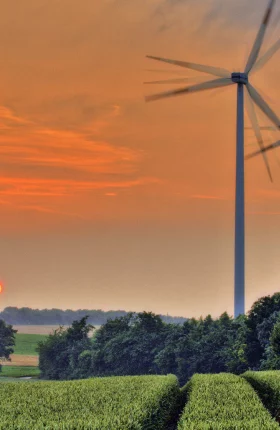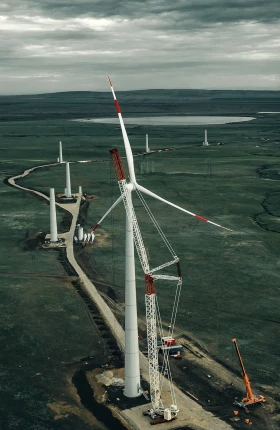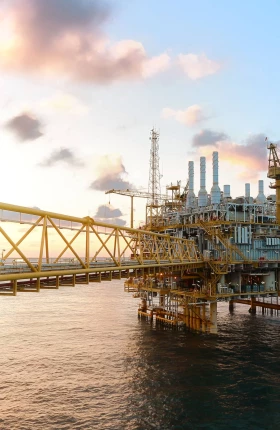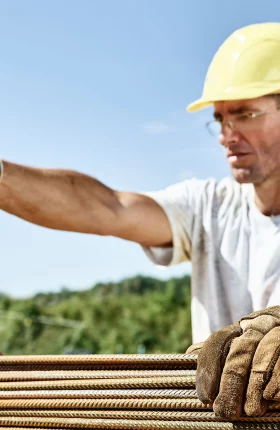Few industries are as threatened by the specter of climate change as the makers of energy-driven machinery. As the world warms, companies in this sector will come under increasing pressure to decarbonize their products—everything from small air conditioners to huge mining equipment—and to reduce the adverse effects of their operations on the climate. The platforms they manufacture operate directly and indirectly in industrial processes that account for most of the greenhouse gas (GHG) emissions responsible for global warming. Consequently, their customers, too, will have to reduce the greenhouse gases they emit, including those from the machinery they use in their own operations.
Already, growing public sentiment in favor of mitigating the effects of global warming is affecting how every company in every industry operates. For machinery makers, three factors are critical. First, the emergence of new, more economically viable technologies will force them to rethink and update their product portfolios. Second, increasingly stiff regulations will force them to take action to reduce their impact on the climate. And third, investors will demand climate-friendly changes in how they do business.
Taken together, these three factors will significantly disrupt machinery makers’ standard operating procedure in several ways—from transforming their new product design to requiring major changes in their business models. Companies that stay ahead of these forces will be able to capture a range of new business opportunities; those that fail to do so will likely fall by the wayside.
Why Now?
The need to move to a net-zero carbon world in hopes of slowing the pace of global warming has been a focus of global political dialogue for decades, and the COVID-19 pandemic has clarified how much work needs to be done. (See “The COVID-19 Effect.”) Progress toward that goal, however, has been fitful. To date, few countries have met their carbon-reduction commitments as prescribed by the Kyoto Protocol, and more recently by the 2016 Paris Agreement.
The COVID-19 Effect
As governments across the globe invest in various fiscal stimulus programs, pressure is growing to channel investment to a green recovery. The government of Canada, for example, recently set up a $750 billion fund focused on reducing the release of methane, an especially potent GHG. The goal is to help companies make the transition to a cleaner asset base while maintaining jobs. We expect to see more programs like this in the coming months and years, as well as a tendency to direct bailout funds to more sustainable companies and sectors. (See “Climate Should Not Be the Virus's Next Victim.”)
The 2020s will be different. As our understanding of the vital importance of slowing global warming grows, three mutually reinforcing trends will accelerate the shift from fossil fuels to other sources of power in the coming decade: technology economics, investor pressure, and regulatory action. Each of these factors has a direct bearing on how machinery makers conduct business.
Technology Economics
The first underlying trend—and the most important for machinery manufacturers—is technology economics. Significant innovations in several technologies will disproportionately drive the global effort to decarbonize.
Over the past decade, for example, the economics of electrification has changed dramatically. On the supply side, wind and solar energy is now competitive with other sources of power, measured in terms of levelized (nonsubsidized) cost of energy. Battery power now costs one-tenth of what it did ten years ago. Meanwhile, new digital technologies such as the industrial Internet of Things (IoT) and highly efficient electric motors are reducing demand for electricity in many industrial and retail applications.
Taken together, these core electrification technologies are poised to drive replacement of a vast installed base of fossil-fuel-driven machines, with clear implications for manufacturers’ legacy product portfolios and supply chains. By 2030, electricity will represent an estimated 30% of global power needs, up from 20% in 2020.
Although they are not yet economically viable, two other technologies will likely further the decarbonization of the world’s industrial base. The first is the proposed “green hydrogen value chain”—the use of clean energy to produce hydrogen for use in fuel cells for transport and as feedstock in the chemicals industry. The second is carbon capture, utilization, and storage (CCUS), an array of methods for capturing and storing CO2, which can then be reused in other nonpolluting industrial processes.
Both technologies require further development to achieve economic viability, but they will be essential for reducing GHG emissions to a sustainable level. We expect that they will capture significant levels of investment over the next decade.
Investor Pressure
Business leaders face increasing pressure from investors to respond to global warming. The “mega-stewards” of capital in our economy are starting to factor a carbon price into their investments. BlackRock, the largest asset manager in the world, recently announced that it would begin scrutinizing management teams’ willingness to derisk their business positions from the threat of climate change. According to a BlackRock report, the company took voting action against the leadership at 53 portfolio companies that were making insufficient progress toward integrating climate risk into their business models or disclosures, and placed another 191 companies on its climate watch list.
This means that the world’s biggest investors are now publicly stating that they consider investments in future carbon emissions to be ill advised, or that they anticipate high future carbon prices—and they are incorporating this risk into their investment strategies. A recent BCG analysis found that, all else being equal, companies with materially higher carbon footprints are already experiencing a valuation discount in the marketplace. In response, machinery companies, including Bosch and Siemens, are setting ambitious goals for reducing their carbon footprint, in some cases planning for zero net emissions.
Regulatory Action
The third underlying trend is regulatory action, spurred by increasing public pressure to offset or reduce carbon emissions. Despite efforts of international bodies to oversee the process, regulatory measures remain fragmented and unpredictable. But governments are increasingly likely to enact policies governing GHGs, and when they do, such regulations can have a major impact on how companies operate and what products they make.
Government regulators around the world have taken several approaches to the problem—primarily mandating the use of cleaner technologies, such as lighting, and setting prices on GHG emissions in hopes of forcing companies to become more climate friendly and to pay the external costs of the emissions they produce.
Several governments and regions have instituted direct carbon taxes either on the fossil fuels that lead to GHG emissions or on the amount of emissions that companies actually produce. While most such schemes impose taxes solely on domestic companies, the EU recently proposed taxing the carbon footprint of goods imported into the region. This so-called “carbon border tax” could change the competitive dynamics of international trade, making US steel exported to the EU more competitive with steel from China, for instance.
More common are the numerous compliance-based cap-and-trade markets, in which regulators cap the amount of GHG emissions companies can produce. Companies can then buy, sell, and trade credits of various kinds in hopes of offsetting their emissions and thus meeting the established caps. Eventually, as the cost of offsetting rises, it will be become more economical for companies to reduce their emissions than to offset them.
Business leaders today face considerable uncertainty with regard to both the expansion of such markets and the future price of credits and offsets. The previous decade witnessed dramatic increases in storm activity, flooding, and fires related to global warming, and it seems likely that cap-and-trade markets will appear in more geographies and across more industries as public sentiment increases for governments to act. Indeed, prices for carbon offsets in established markets are already rising as regulators ramp up their decarbonization efforts. For example, the carbon price in the EU’s cap-and-trade market has increased from $8 per ton of CO2 equivalent (CO2e) in 2018 to more than $25 per ton of CO2e today.
Because governments tend to regulate where it hurts them least, new regulations typically fall on suppliers rather than consumers. It is virtually impossible to predict where regulations may fall next, but output quotas for internal combustion engines or increased efficiency requirements for air conditioners, for example, are more likely than such measures as direct taxes on fuel at the pump. It is important to recognize that regulatory carrots can be just as disruptive as regulatory sticks. For example, tax credits introduced in the US to promote the construction of renewable energy facilities propelled innovation in wind and solar power at a time when those technologies were not yet economically viable.
Further contributing to the next decade’s uncertain regulatory environment is the likelihood of sudden regulatory action in response to the development of new, economically viable green technologies. When governments choose to regulate a particular product segment, they do so quickly. The shift from incandescent to LED light bulbs took just ten years across OECD countries. The US’s Tier 4 diesel engine regulations required company compliance within just five years. In both cases, the separation of winners from losers occurred rapidly, with major shifts in market share away from those least prepared to respond to the new regulatory regime.
Seven Disruptions
As they reinforce one another over the coming decade, the three underlying trends described above will eventually trigger a series of disruptions that will completely transform the machinery sector, altering manufacturers’ operations and overall strategy. How companies fare during this tumultuous period will depend largely on where they stand now in relation to climate change. That, in turn, depends on how exposed their portfolio of businesses is to a decarbonizing world, and on how operationally resilient they are in the face of shifting stakeholder demands and the impacts of global warming.
End markets are disrupted. Every machinery maker is uniquely exposed to multiple end markets, many of which face a highly uncertain future in a decarbonizing world. A manufacturer’s exposure depends largely on the amount of Scope 1 emissions companies in its end market produce as a direct result of its operations. (See “Measuring GHG Emissions.”)
Measuring GHG Emissions
- Scope 1 emissions consist of GHGs emitted during the course of operations, from the process of generating electricity at a natural-gas- or coal-fired power plant, for example, or from burning fuel to power a furnace in a manufacturing facility.
- Scope 2 emissions include all the indirect emissions attributable to a company as it uses electricity generated by burning fossil fuels. Taken together, Scope 1 and Scope 2 emissions are a powerful yardstick for measuring an individual company’s contribution to overall emissions.
- Scope 3 emissions include all the emissions produced by a company’s suppliers and customers—not including Scope 2 emissions, for which the company is indirectly responsible.
For example, the transportation sector accounts for about 70% of global crude oil consumption; and as the world decarbonizes, demand for crude oil will fall. Although the exact date of peak oil demand is highly uncertain, some analysts are forecasting that it will occur by or before 2030—and once the use of oil begins to decline, it will disrupt an entire value chain of machinery products and associated services that are exposed to the oil industry. This includes everything from the huge pumps and off-highway vehicles used in extracting oil and gas to the machinery needed to run large-scale refineries.
Or consider diesel locomotives, a machine segment whose growth is driven largely by ton-miles of cargo transported. Because coal is the heaviest and most common cargo on US railroads, the decline in coal-powered electricity generation will have an increasingly significant second-order impact on the market for diesel locomotives. (See Exhibit 1.)
Product design priorities shift. As customers of machinery companies try to meet increasingly ambitious decarbonization goals in the 2020s, the importance of providing sustainable machinery product platforms will grow. Qualities such as efficiency and flexibility will become more and more critical factors in customers’ purchasing decisions, as will the ability to recycle or repurpose the machines they buy, once their useful first life is over.
New participation models and choices emerge. The automotive industry is racing toward a future in which transportation is electrified, automated, and shared. In many ways, the machinery sector is no different as it strives to provide new levels of efficiency and automation in order to meet the goals of decarbonization.
As it does so, value will shift to new points in the machinery value chain, and manufacturers will have to make choices about the decarbonization technologies—battery power, IoT-enabled software for efficiency gains, and others—they use. Should they manufacture the emerging component technology or buy it? Should they invest in services to drive more value for their customer’s operations? What roles should the IoT and data play in their strategy to make the best products and generate maximum value for customers?
At the same time, entirely new machine segments will emerge, offering significant growth and the potential to offset declines elsewhere. BCG estimates that the new kinds of machinery necessary to meet the goals of the Paris Agreement will require an investment of more than $11 trillion from now until 2050—an enormous profit pool that all machinery makers should examine closely.
Business models change. In addition to making key portfolio choices, machinery manufacturers must make critical decisions about the business models they pursue. For example, many new machinery technologies contain fewer “wear parts,” which significantly reduces the value of businesses that focus on maintenance and parts replacement. In addition, new machines will be used in completely new ways—for example, as part of a larger shared and automated system that operates through user software, with the potential to create more value through the sale of services as well as of the machine itself.
Shifting from gas turbines to wind turbines, for example, demands a very different approach to value capture. Most life-cycle profits for a gas turbine come from replacement part sales rather than from sale of the initial product. In contrast, wind turbines require less maintenance and have fewer, less technical parts—and those parts wear out less frequently. Companies that make them must focus not only on the profit pools available through replacement parts but also on the initial sale and on ancillary services to complement the turbine’s operations. Vestas, a wind turbine OEM, offers software tools and data analytics tied to wind farm optimization and forecasting. Both machine segments serve the needs of providing power, but what it takes to win in wind turbine manufacturing is very different from what works for gas turbines.
Stakeholders demand reductions in Scope 1 and Scope 2 emissions. A new generation of investors, customers, and employees will increasingly demand that all businesses do their part to reduce emissions. Many machinery firms are already publicizing their efforts to reduce their Scope 1 and Scope 2 emissions. Bosch Rexroth, for example, has committed to becoming carbon neutral in Scope 1 and Scope 2 emissions by 2030. Options include installing more efficient machinery, using clean energy sources in their manufacturing facilities, and buying carbon offsets, among others.
Value chains become circular. In contrast to Scope 1 and Scope 2 emissions, Scope 3 emissions encompass a machine’s total emissions footprint, including the materials used in producing the machine and the emissions it generates throughout its life cycle. As machinery customers seek to reduce their own emissions footprint, they will begin demanding machines made with greener materials, such as “green steel,” and machines that can be recycled or repurposed once their useful first life is over.
The effort to produce such machines will significantly affect machinery makers’ design priorities and business models. California-based Solar Turbines is perhaps the best example of a machinery company that has made a business out of building recyclable machines: many of its machines survive multiple owners, after which they are dismantled, and all reusable parts are remanufactured for use in newer machines. Another example is Vestas, which has announced that it will soon require all of its suppliers to comply with its goal of making wind turbines 100% recyclable.
Weather, sea-level, and operational risks increase. Climate change will have a growing impact on machinery business operations as plants, supply chains, and service operations find themselves at greater risk from harmful weather-related events. Machinery makers may also need to revise the underlying environmental assumptions they include in their service contracts and warranties, such as temperature limits and exposure to water.
Keeping Ahead
It is already incumbent on leaders at every machinery manufacturer to assess their company’s current position with regard to coming disruptions and to plan accordingly. They should take four specific actions to navigate successfully through the 2020s.
Update a participation model for a green future. The disruptions of the 2020s will have a direct impact on existing machinery businesses. Leaders need to examine their existing businesses and markets, and consider multiple scenarios for how the 2020s will unfold, factoring in such issues as middle- and long-term changes in their end markets, emerging customer expectations for greener products and services, and regulatory uncertainty.
This analysis will reveal opportunities for developing new machinery technologies and segments and new business models. These may include investing in new positions in the value chain, building a beachhead in an emerging green machinery segment, and building a digital services business around an existing segment that is suffering from declining parts revenues. Our analysis indicates that, taken together, the business opportunity for machinery makers adds up to $12 trillion through 2050. (See Exhibit 2.)
Reduce Scope 1 and Scope 2 emissions. Every machinery company that operates productive assets produces a carbon footprint. To reduce that footprint and to clarify which emissions-abating projects have the lowest marginal cost, business leaders need to understand their firm’s unique “abatement curve.” By understanding its specific curve, a company can act in the most cost-efficient manner now, while also determining the prices at which decarbonization projects become more economically attractive than paying an emissions tax or offset. Over time, decarbonization projects will feel less like “cost” and more like “cost out.”
Green the supply chain. “You are what you eat,” as the expression goes, and this is no less true for machinery than for people. Increasingly, machinery companies will need to assemble their machines from component suppliers that have an acceptable carbon footprint, and they will need to ensure that their machines are truly sustainable—easy to repair, rebuild, and recycle. The most proactive machine makers are actively looking upstream at their supplier’s carbon footprints and seeking ways to rebuild and recycle their platforms at the end of their first useful life. Such actions can have a positive impact on the prices they can charge for their machines, as well as offering profitable new service business opportunities.
Bolster operational risk management practices. Among the key lessons of the COVID-19 crisis is the importance of achieving resiliency and maintaining visibility into supply chains. Going forward, the impact of climate change will add further risks to the supply chain and to sales and service channels. Already, proactive leaders are building new capabilities, such as climate modeling to improve their assessment of specific geographical risks, and incorporating them into their supply chains and into certain pricing decisions such as extended warranties and service contact guarantees.
The COVID-19 crisis has made the importance of being prepared for future disruptions painfully clear to business leaders. Its effect on reducing global GHG emissions has been impressive, but that impact only goes to show how much more work remains to be done if we are to make real progress against climate change.
Over the next decade, machinery manufacturers must contend with various severely disruptive forces that will have profound effects on their operations and business models. How machinery industry leaders respond will separate the winners from the also-rans. Even more importantly, their actions will contribute greatly to our overall efforts to combat global warming.
